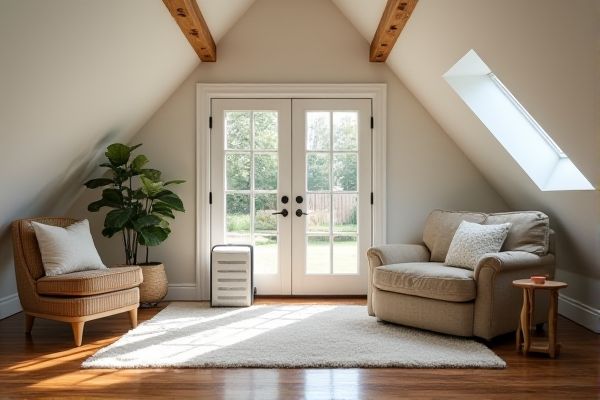
Attic air purifiers are designed to handle the unique dust, mold, and temperature fluctuations found in upper home spaces, while downstairs air purifiers focus on improving air quality in living areas with higher foot traffic and different pollutant profiles. Discover how choosing the right air purifier for your specific home zone can enhance Your indoor environment by reading the full comparison.
Table of Comparison
| Feature | Attic Air Purifier | Downstairs Air Purifier |
|---|---|---|
| Air Quality Improvement | Targets attic air, removes dust, mold spores common in attics | Improves living area air, filters allergens, pet dander, and pollutants |
| Efficiency | Less effective for overall home air circulation | More efficient in cleaning frequently occupied spaces |
| Humidity Control | Helps reduce attic moisture, prevents mold growth | Maintains comfortable humidity for health and comfort |
| Noise Level | Less critical, often installed away from living spaces | Must be quieter for comfort in living areas |
| Maintenance | Less frequent but may be harder to access | More frequent, easier access for filter changes |
| Cost | Generally lower initial cost, fewer features | May have higher cost with advanced filtration options |
Attic Air Purifier vs Downstairs Air Purifier: Key Differences
Attic air purifiers typically target airborne pollutants such as dust, mold spores, and allergens concentrated in the attic's confined space, improving overall home air quality and preventing contamination from spreading downstairs. Downstairs air purifiers focus on living areas where occupants spend most time, addressing common household pollutants like pet dander, cooking odors, and volatile organic compounds (VOCs) to enhance immediate breathing environments. The key differences lie in location-specific pollutant sources, air volume capacity, and filtration technology tailored to either the attic's limited ventilation or the larger, occupied downstairs spaces.
Understanding Air Quality Challenges in Attic and Downstairs Spaces
Attic air purifiers address unique air quality challenges such as higher temperatures, increased dust, and limited ventilation, which can trap pollutants and allergens more intensely than downstairs spaces. Downstairs air purifiers focus on reducing common indoor contaminants like pet dander, cooking odors, and outdoor pollutants entering through doors and windows. Understanding these differences helps you choose an air purifier designed to optimize air quality based on the specific conditions of your attic or main living areas.
Size and Coverage: Matching Purifier Capacity to Space
Attic air purifiers typically require higher capacity units due to larger, more open spaces and potential for increased dust and allergens compared to downstairs areas. Choosing a purifier with appropriate Clean Air Delivery Rate (CADR) and square footage coverage ensures efficient air cleaning tailored to your attic or living spaces. Matching your air purifier's size and coverage precisely to the room prevents underperformance and maximizes air quality improvements.
Types of Air Pollutants in Attic and Downstairs Areas
Attic air purifiers target airborne mold spores, dust mites, and attic-specific pollutants like insulation fibers and trapped moisture-related contaminants. Downstairs air purifiers focus on common indoor pollutants such as pet dander, cooking smoke, pollen, and VOCs from household products. Selecting purifiers with HEPA filters for particulate matter and activated carbon filters for odors enhances air quality tailored to each area's unique pollution profile.
Noise Levels: What to Expect from Each Location
Attic air purifiers typically operate with lower noise impact due to the natural sound insulation provided by attic spaces and structural barriers, making them less disruptive. Downstairs air purifiers, positioned in more frequently occupied areas, often require advanced noise-reduction technology to maintain quiet operation without compromising air quality. Understanding the noise levels of purifiers in each location helps optimize comfort and ensures cleaner air without auditory disturbance.
Energy Efficiency Comparison: Attic vs Downstairs Use
Attic air purifiers typically consume less energy due to lower usage frequency and smaller space coverage compared to downstairs units, which operate longer and handle larger air volumes. Your choice impacts overall energy efficiency; selecting an attic purifier for infrequent use reduces electricity costs, while downstairs purifiers require models with energy-efficient ratings like ENERGY STAR to manage continuous operation. Understanding the distinct energy demands of each location ensures optimal energy savings and indoor air quality maintenance.
Installation and Placement Considerations
Installing an attic air purifier requires careful attention to ventilation and temperature fluctuations, often necessitating models designed for higher humidity and temperature resistance, while downstairs air purifiers benefit from more stable indoor conditions and easier access for maintenance. Placement in the attic must ensure proper airflow without obstructing insulation or vents, whereas downstairs units should be positioned centrally in living spaces for optimal air circulation. Both installations demand power source accessibility and consideration of noise levels to maintain comfort throughout the home.
Maintenance Requirements for Each Air Purifier
Attic air purifiers typically require more frequent maintenance due to exposure to temperature fluctuations and dust accumulation in less insulated spaces. Downstairs air purifiers benefit from more stable environmental conditions, resulting in longer intervals between filter changes and cleaning. Regular inspection of both units is essential to ensure optimal performance and prolong air purifier lifespan.
Cost Analysis: Initial Investment and Operating Expenses
Attic air purifiers typically require higher initial investment due to the need for specialized installation and enhanced durability against attic conditions like heat and dust. Operating expenses for attic units often increase because of the tougher environment, leading to more frequent filter replacements and higher energy consumption. In contrast, downstairs air purifiers generally have lower initial costs and reduced maintenance, benefiting from more stable indoor conditions and easier access for filter changes.
Choosing the Best Air Purifier for Your Home’s Unique Needs
Selecting the best air purifier depends on your home's specific layout and air quality challenges, with attic air purifiers ideal for eliminating dust and allergens before they circulate downstairs. Downstairs air purifiers target living spaces directly, improving comfort where your family spends most time. Your choice should consider factors like airflow patterns, room size, and pollution sources to ensure optimal air purification throughout your home.
 homyna.com
homyna.com